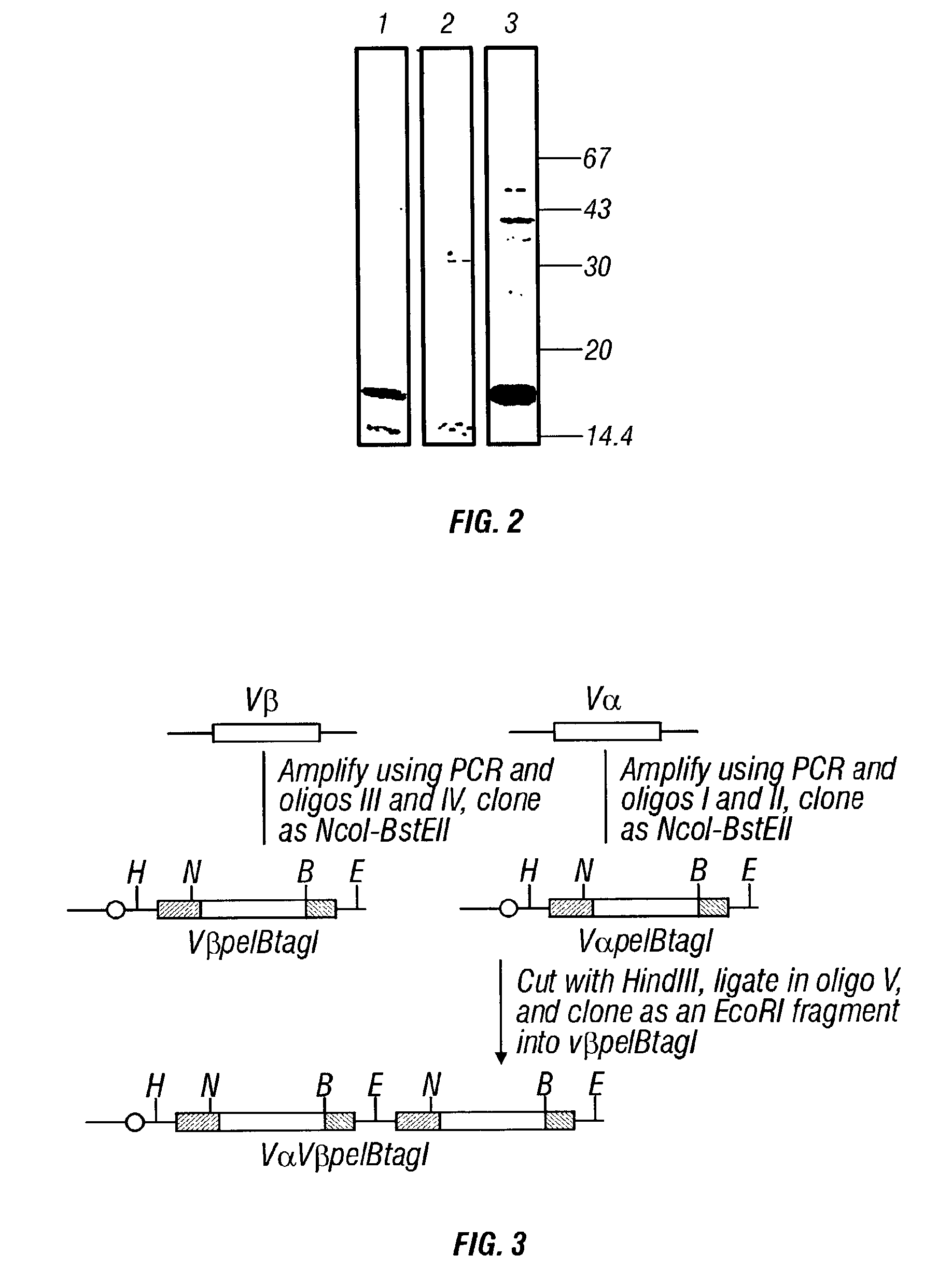Secretion of T cell receptor fragments from recombinant escherichia coli cells
a technology escherichia coli, which is applied in the field of secretion of t cell receptor fragments from recombinant escherichia coli cells, can solve the problems of inability to produce inability to express and secrete these proteins in prokaryotic hosts, and inability to achieve single t-cell receptor domain production
- Summary
- Abstract
- Description
- Claims
- Application Information
AI Technical Summary
Problems solved by technology
Method used
Image
Examples
example 2
[0105] The following are examples of expression of V.sub..alpha., V.sub..beta. and V.sub..alpha.V.sub..beta. T-cell receptor domains employing E. coli hosts transformed with the vectors of Example 1.
[0106] Expression of V.sub..alpha., V.sub..beta. and SCV.sub..alpha.V.sub..beta. Proteins
[0107] Detection of unpurified recombinant protein in culture supernatants or osmotic shock fractions was performed as follows:
[0108] E. coli recombinants harboring V.sub..alpha.pelBmyc, V.sub..beta.pelBmyc V.sub..alpha.V.sub..beta.pelBmyc, or scV.sub..alpha.V.sub..beta.PelBmyc were grown up in 2.times.TY (or 4.times.TY) plus 100 .mu.l ampicillin and 1% (wt:vol) glucose to early stationary phase, pelleted by centrifugation, washed once in either 2.times.TY (or 4.times.TY) or 50 mM NaCl and then induced by resuspension in 2.times.TY (or 4.times.TY) plus 100 .mu.g / ml ampicillin and 1 mM isopropyl-.beta.-D-thiogalactopyranoside (IPTG) for 14-16 hrs. Cultures were grown and induced at 37.degree. C. with ...
example 3
[0115] The following example illustrates that the expression vectors of Example 1 are not limited to expression in E. coli. Serratia marcescens was employed as host in the following example.
[0116] Expression and Secretion of TCR Single Chain TCRs from S. marcescens
[0117] The plasmid scV.sub..alpha.V.sub..beta.pelBhis was transformed into S. marcescens by electroporation and transformants selected on 2.times.TY agar plates with 1 mg / ml ampicillin and 1% w / v glucose, or minimal media (Sambrook et al., 1989) plates plus 1 mg / ml ampicillin plus 1% w / v glucose. Transformants were grown up in minimal media plus 10% w / v casamino acids, 5% w / v glycerol, 0.5 mg / ml ampicillin (MCGA media) at 30.degree. C. for 24 hrs with aeration (250 rpm). 30-50 ml of this culture was used to inoculate 500 ml of the same MCGA media and grown for 12-16 hrs overnight at 30.degree. C. with aeration (250 rpm) and then IPTG added to a final concentration of 0.2-0.5 mM. Cells were induced for 12-24 hrs by growth a...
example 4
[0119] The folded state of the recombinant TCR fragments was assessed by circular dichroism (CD) analysis. Results indicated significant proportion of .beta.-sheet structure, strongly suggesting native folding.
[0120] Circular Dichroism Analysis of Expressed TCR Proteins
[0121] FIG. 11 shows the circular dichroism spectra of recombinant TCR proteins. The recombinant TCR fragments were purified using the methodology described above, from E. coli cells harboring V.sub..alpha.pelBhis, V.sub..beta.pelBhis and scV.sub..alpha.V.sub..beta.-pelBhis and dialyzed into 10 mM sodium phosphate pH7.0 prior to CD analysis. As a comparison, the immunoglobulin scFv fragment derived from the D1.3 antibody (Ward et al., 1989) was purified and used. This fragment was expressed from a plasmid construction derivative of pSW2 (Ward et al., 1989; McCafferty et al., 1990). The scFv was purified from the culture supernatant of induced cultures using lysozyme sepharose (Ward et al., 1989) and dialyzed against 1...
PUM
| Property | Measurement | Unit |
|---|---|---|
| Angle | aaaaa | aaaaa |
| Angle | aaaaa | aaaaa |
| Metallic bond | aaaaa | aaaaa |
Abstract
Description
Claims
Application Information
 Login to View More
Login to View More - R&D
- Intellectual Property
- Life Sciences
- Materials
- Tech Scout
- Unparalleled Data Quality
- Higher Quality Content
- 60% Fewer Hallucinations
Browse by: Latest US Patents, China's latest patents, Technical Efficacy Thesaurus, Application Domain, Technology Topic, Popular Technical Reports.
© 2025 PatSnap. All rights reserved.Legal|Privacy policy|Modern Slavery Act Transparency Statement|Sitemap|About US| Contact US: help@patsnap.com



